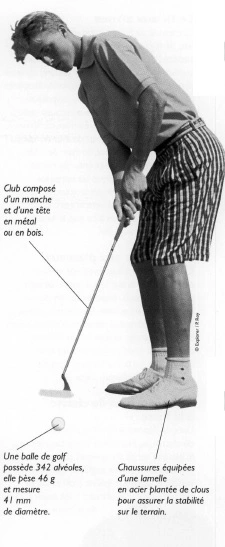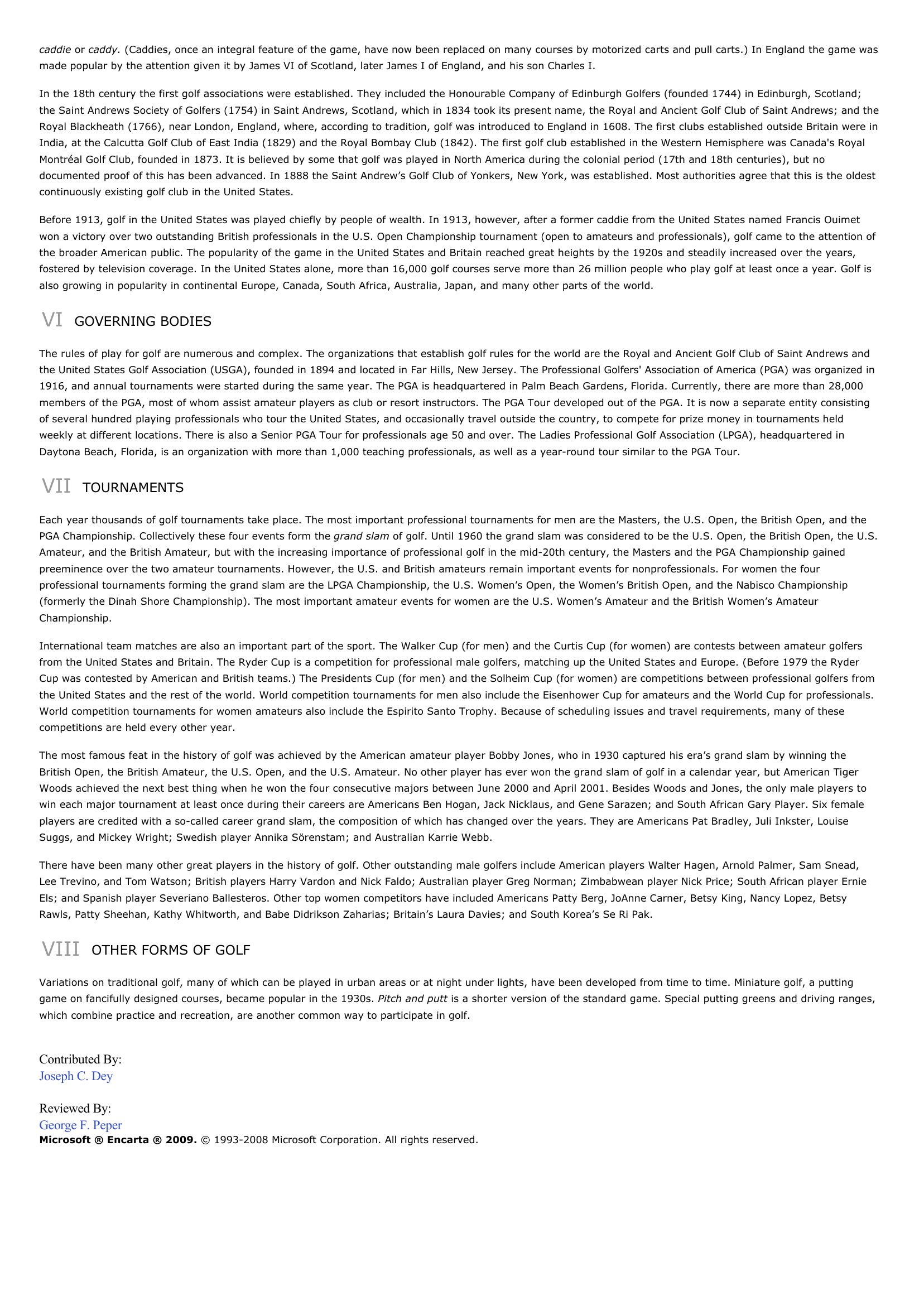Golf. I INTRODUCTION Golf, outdoor game in which individual players use specially designed
Publié le 14/05/2013
Extrait du document


«
caddie or caddy. (Caddies, once an integral feature of the game, have now been replaced on many courses by motorized carts and pull carts.) In England the game was made popular by the attention given it by James VI of Scotland, later James I of England, and his son Charles I.
In the 18th century the first golf associations were established.
They included the Honourable Company of Edinburgh Golfers (founded 1744) in Edinburgh, Scotland;the Saint Andrews Society of Golfers (1754) in Saint Andrews, Scotland, which in 1834 took its present name, the Royal and Ancient Golf Club of Saint Andrews; and theRoyal Blackheath (1766), near London, England, where, according to tradition, golf was introduced to England in 1608.
The first clubs established outside Britain were inIndia, at the Calcutta Golf Club of East India (1829) and the Royal Bombay Club (1842).
The first golf club established in the Western Hemisphere was Canada's RoyalMontréal Golf Club, founded in 1873.
It is believed by some that golf was played in North America during the colonial period (17th and 18th centuries), but nodocumented proof of this has been advanced.
In 1888 the Saint Andrew’s Golf Club of Yonkers, New York, was established.
Most authorities agree that this is the oldestcontinuously existing golf club in the United States.
Before 1913, golf in the United States was played chiefly by people of wealth.
In 1913, however, after a former caddie from the United States named Francis Ouimetwon a victory over two outstanding British professionals in the U.S.
Open Championship tournament (open to amateurs and professionals), golf came to the attention ofthe broader American public.
The popularity of the game in the United States and Britain reached great heights by the 1920s and steadily increased over the years,fostered by television coverage.
In the United States alone, more than 16,000 golf courses serve more than 26 million people who play golf at least once a year.
Golf isalso growing in popularity in continental Europe, Canada, South Africa, Australia, Japan, and many other parts of the world.
VI GOVERNING BODIES
The rules of play for golf are numerous and complex.
The organizations that establish golf rules for the world are the Royal and Ancient Golf Club of Saint Andrews andthe United States Golf Association (USGA), founded in 1894 and located in Far Hills, New Jersey.
The Professional Golfers' Association of America (PGA) was organized in1916, and annual tournaments were started during the same year.
The PGA is headquartered in Palm Beach Gardens, Florida.
Currently, there are more than 28,000members of the PGA, most of whom assist amateur players as club or resort instructors.
The PGA Tour developed out of the PGA.
It is now a separate entity consistingof several hundred playing professionals who tour the United States, and occasionally travel outside the country, to compete for prize money in tournaments heldweekly at different locations.
There is also a Senior PGA Tour for professionals age 50 and over.
The Ladies Professional Golf Association (LPGA), headquartered inDaytona Beach, Florida, is an organization with more than 1,000 teaching professionals, as well as a year-round tour similar to the PGA Tour.
VII TOURNAMENTS
Each year thousands of golf tournaments take place.
The most important professional tournaments for men are the Masters, the U.S.
Open, the British Open, and thePGA Championship.
Collectively these four events form the grand slam of golf.
Until 1960 the grand slam was considered to be the U.S.
Open, the British Open, the U.S. Amateur, and the British Amateur, but with the increasing importance of professional golf in the mid-20th century, the Masters and the PGA Championship gainedpreeminence over the two amateur tournaments.
However, the U.S.
and British amateurs remain important events for nonprofessionals.
For women the fourprofessional tournaments forming the grand slam are the LPGA Championship, the U.S.
Women’s Open, the Women’s British Open, and the Nabisco Championship(formerly the Dinah Shore Championship).
The most important amateur events for women are the U.S.
Women’s Amateur and the British Women’s AmateurChampionship.
International team matches are also an important part of the sport.
The Walker Cup (for men) and the Curtis Cup (for women) are contests between amateur golfersfrom the United States and Britain.
The Ryder Cup is a competition for professional male golfers, matching up the United States and Europe.
(Before 1979 the RyderCup was contested by American and British teams.) The Presidents Cup (for men) and the Solheim Cup (for women) are competitions between professional golfers fromthe United States and the rest of the world.
World competition tournaments for men also include the Eisenhower Cup for amateurs and the World Cup for professionals.World competition tournaments for women amateurs also include the Espirito Santo Trophy.
Because of scheduling issues and travel requirements, many of thesecompetitions are held every other year.
The most famous feat in the history of golf was achieved by the American amateur player Bobby Jones, who in 1930 captured his era’s grand slam by winning theBritish Open, the British Amateur, the U.S.
Open, and the U.S.
Amateur.
No other player has ever won the grand slam of golf in a calendar year, but American TigerWoods achieved the next best thing when he won the four consecutive majors between June 2000 and April 2001.
Besides Woods and Jones, the only male players towin each major tournament at least once during their careers are Americans Ben Hogan, Jack Nicklaus, and Gene Sarazen; and South African Gary Player.
Six femaleplayers are credited with a so-called career grand slam, the composition of which has changed over the years.
They are Americans Pat Bradley, Juli Inkster, LouiseSuggs, and Mickey Wright; Swedish player Annika Sörenstam; and Australian Karrie Webb.
There have been many other great players in the history of golf.
Other outstanding male golfers include American players Walter Hagen, Arnold Palmer, Sam Snead,Lee Trevino, and Tom Watson; British players Harry Vardon and Nick Faldo; Australian player Greg Norman; Zimbabwean player Nick Price; South African player ErnieEls; and Spanish player Severiano Ballesteros.
Other top women competitors have included Americans Patty Berg, JoAnne Carner, Betsy King, Nancy Lopez, BetsyRawls, Patty Sheehan, Kathy Whitworth, and Babe Didrikson Zaharias; Britain’s Laura Davies; and South Korea’s Se Ri Pak.
VIII OTHER FORMS OF GOLF
Variations on traditional golf, many of which can be played in urban areas or at night under lights, have been developed from time to time.
Miniature golf, a puttinggame on fancifully designed courses, became popular in the 1930s.
Pitch and putt is a shorter version of the standard game.
Special putting greens and driving ranges, which combine practice and recreation, are another common way to participate in golf.
Contributed By:Joseph C.
Dey
Reviewed By:George F.
PeperMicrosoft ® Encarta ® 2009. © 1993-2008 Microsoft Corporation.
All rights reserved..
»
↓↓↓ APERÇU DU DOCUMENT ↓↓↓
Liens utiles
- FOOTBALL a match two teams playing against each other in a 90-minute game of football a pitch the area where footballers play a match a referee the person who makes sure that the players follow the rules.
- Luciano PavarottiIINTRODUCTIONLuciano PavarottiRenowned Italian tenor Luciano Pavarotti was known for his mastery of the highest notes of a tenor's range and for hisjovial personality, which helped him earn a wide popular following.
- Ernest Hemingway I INTRODUCTION Ernest Hemingway Twentieth-century American author Ernest Hemingway wrote novels and stories that reflected his rich life experiences as a war correspondent, outdoor sportsman, and bullfight enthusiast.
- Acting I INTRODUCTION Lee Strasberg American acting teacher Lee Strasberg was best known for his association with the Actors Studio, of which he became the artistic director in 1951.
- Édouard Manet I INTRODUCTION Manet: Tradition and Innovation French impressionist painter Édouard Manet shocked art audiences in Paris with Le déjeuner sur l'herbe (The Luncheon on the Grass; 1863, Musée d'Orsay, Paris), which depicts a nude woman at a woodland picnic.


